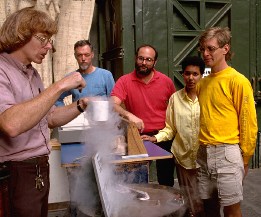| view a science museum as a collection of props that constitute an interlocking web of mini-curricula that can be used by teachers at all levels, by the visitors who come hoping to instruct their children, their friends or their parents or by our own staff when they use the place for learning or for teaching classes. We are continually filling in and adding on to these interlocking curriculitos and hopefully we will be able to do so for years to come. As a consequence we never have a formal public opening of any but traveling exhibit shows. | visitors. It can reestablish the visitors' confidence in their own ability to understand and to learn. It can give them a sense of roots in the past, it can help them realize that human beings and human acts are a part of nature. More simply, it can engender a comfortable familiarity with aspects of culture that they may have rejected as inaccessible or as undesirable. It is hard to predict or to assess these general effects. One woman told us that after being at the Exploratorium she went home and, for the first time in her life, put a plug on a lamp cord. Nothing in the Exploratorium could have instructed her how to do so. She must have felt that since she had made sense of some of the difficult ideas in the museum, she could make sense of other things as well. The Audience There is one piece of oft-repeated advice to which we have not paid the slightest attention. Over and over again I have been lectured at by exhibit designers with the statement "You have to decide who your audience will be". We do recognize that it is essential that neither I nor the staff are bored by our exhibits, that we learn something as we make them and that we enjoy showing them to people, especially our friends and colleagues, over and over again. The best physicists that I know usually learn something in the place and are also delighted by some of the things they already know because the presentation is novel, illuminating or beautiful. But as far as we can determine there is no age limit, no training limit nor any cultural limit to the range of people who use and enjoy the place. Preschool groups and old-folks-home groups come and come back. Mentally or sensory retarded groups repeatedly come and special classes for gifted students use the place as the basis for a variety of projects. It is one of the few formal institutions that attracts teenagers. There are two things misleading about the statement "You have to decide who your audience is". In the first place it is possible to make many, if not most, of the exhibits so that | ||
 | |||
Master teacher Paul Doherty does a demonstration for teachers on the museum floor. | |||
| We, of course, also think of the Exploratorium in other ways than as a collection of props for teaching mini-curricula. It is a place for sightseeing, a woods of natural phenomena through which to wander. Sightseeing is more than pleasurable, it can build the experiences and the intuitions on which other opportunities for learning rely; it can arouse curiosity and, in a broad sense, it can help people determine where they are going and where they will want to make their home. Many of the scientists who visit the Exploratorium have attributed the fact that they are scientists to their early experiences in the Museum of Science and Industry in Chicago. In addition to providing opportunities for sightseeing and for providing a library of teaching props, a museum can, in an overall way make very deep, lasting impressions on its | |||